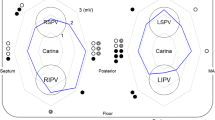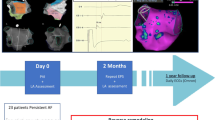Abstract
Purpose
The usefulness of electrogram (EGM)-based information has been reported for assessing lesion transmurality during atrial fibrillation (AF) ablation, but the wall thickness of the pulmonary vein-left atrial (PV-LA) junction has not been considered. We conducted a study to evaluate the relation between PV-LA junction wall thickness and the presence of adenosine triphosphate (ATP)-provoked dormant PV conduction.
Methods
Eighteen AF patients underwent extensive encircling pulmonary vein isolation (EEPVI) with a target CF of >10 g. RF energy was delivered point-by-point at a power setting of 25–30 W for 30 s, and EGM-based information (change in filtered unipolar EGM morphology and bipolar EGM amplitude), decrease in impedance, CF, and CT-based measurement of the PV-LA junction wall thickness were characterized at sites of ATP-provoked dormant conduction.
Results
After EEPVI, ATP-induced dormant conduction was observed at 12 of the 288 PV sites (8 segments per ipsilateral PVs × 2 × 18 patients). Of the 974 ablation points, 72 were located at dormant conduction sites and were strongly associated with thickened PV-LA junction walls (1.02± 0.23 vs. 0.86 ± 0.26 mm, p < 0.0001) and decreased impedance (13.3 ± 6.4 vs. 14.9 ± 7.1 Ω, p = 0.0498) but not with EGM-based information or CF. Multivariate analysis identified the thickened PV-LA junction wall as the strongest predictor of dormant conduction.
Conclusions
A thickened PV-LA junction wall is a robust predictor of ATP-provoked dormant conduction; EGM-based information appears to be insufficient for ensuring adequate lesions during CF-guided EEPVI.




Similar content being viewed by others
References
Lee G, Sanders P, Kalman JM. Catheter ablation of atrial arrhythmias: state of the art. Lancet. 2012;380:1509–19.
Gerstenfeld EP, Callans DJ, Dixit S, Zado E, Marchlinski FE. Incidence and location of focal atrial fibrillation triggers in patients undergoing repeat pulmonary vein isolation: implications for ablation strategies. J Cardiovasc Electrophysiol. 2003;14:685–90.
Ouyang F, Antz M, Ernst S, Hachiya H, Mavrakis H, Deger FT, et al. Recovered pulmonary vein conduction as a dominant factor for recurrent atrial tachyarrhythmias after complete circular isolation of the pulmonary veins: lessons from double Lasso technique. Circulation. 2005;111:127–35.
Verma A, Kilicaslan F, Pisano E, Marrouche NF, Fanelli R, Brachmann J, et al. Response of atrial fibrillation to pulmonary vein antrum isolation is directly related to resumption and delay of pulmonary vein conduction. Circulation. 2005;112:627–35.
Willems S, Steven D, Servatius H, Hoffmann BA, Drewitz I, Müllerleile K, et al. Persistence of pulmonary vein isolation after robotic remote-navigated ablation for atrial fibrillation and its relation to clinical outcome. J Cardiovasc Electrophysiol. 2010;21:1079–84.
Arentz T, Macle L, Kalusche D, Hocini M, Jais P, Shah D, et al. “Dormant” pulmonary vein conduction revealed by adenosine after ostial radiofrequency catheter ablation. J Cardiovasc Electrophysiol. 2004;15:1041–7.
Otomo K, Uno K, Fujiwara H, Isobe M, Iesaka Y. Local unipolar and bipolar electrogram criteria for evaluating the transmurality of atrial ablation lesions at different catheter orientations relative to the endocardial surface. Heart Rhythm. 2010;7:1291–300.
Gepstein L, Hayam G, Shpun S, Cohen D, Ben-Haim SA. Atrial linear ablations in pigs. Chronic effects on atrial electrophysiology and pathology. Circulation. 1999;100:419–26.
Azegami K, Satake S, Okishige K, Sasano T, Ohira H, Yamashita K. Monitoring the local electrogram at the ablation site during radiofrequency application for common atrial flutter. Jpn Circ J. 1998;62:559–64.
Ikeda A, Nakagawa H, Lambert H, Shah DC, Fonck E, Yulzari A, et al. Relationship between catheter contact force and radiofrequency lesion size and incidence of steam pop in the beating canine heart: electrogram amplitude, impedance, and electrode temperature are poor predictors of electrode-tissue contact force and lesion size. Circ Arrhythm Electrophysiol. 2014;7:1174–80.
Reichlin T, Lane C, Nagashima K, Nof E, Chopra N, Ng J, et al. Feasibility, efficacy, and safety of radiofrequency ablation of atrial fibrillation guided by monitoring of the initial impedance decrease as a surrogate of catheter contact. J Cardiovasc Electrophysiol. 2015;26:390–6.
Reddy VY, Shah D, Kautzner J, Schmidt B, Saoudi N, Herrera C, et al. The relationship between contact force and clinical outcome during radiofrequency catheter ablation of atrial fibrillation in the TOCCATA study. Heart Rhythm. 2012;9:1789–95.
Neuzil P, Reddy VY, Kautzner J, Petru J, Wichterle D, Shah D, et al. Electrical reconnection after pulmonary vein isolation is contingent on contact force during initial treatment: results from the EFFICAS I study. Circ Arrhythm Electrophysiol. 2013;6:327–33.
Takahashi K, Okumura Y, Watanabe I, Nagashima K, Sonoda K, Sasaki N, et al. Relation between left atrial wall thickness in patients with atrial fibrillation and intracardiac electrogram characteristics and ATP-provoked dormant pulmonary vein conduction. J Cardiovasc Electrophysiol. 2015;26:597–605.
Matsuo S, Yamane T, Date T, Inada K, Kanzaki Y, Tokuda M, et al. Reduction of AF recurrence after pulmonary vein isolation by eliminating ATP-induced transient venous re-conduction. J Cardiovasc Electrophysiol. 2007;18:704–8.
Kumagai K, Naito S, Nakamura K, Hayashi T, Fukazawa R, Sato C, et al. ATP-induced dormant pulmonary veins originating from the carina region after circumferential pulmonary vein isolation of atrial fibrillation. J Cardiovasc Electrophysiol. 2010;21:494–500.
Hachiya H, Hirao K, Takahashi A, Nagata Y, Suzuki K, Maeda S, et al. Clinical implications of reconnection between the left atrium and isolated pulmonary veins provoked by adenosine triphosphate after extensive encircling pulmonary vein isolation. J Cardiovasc Electrophysiol. 2007;18:392–8.
Okumura Y, Watanabe I, Nagashima K, Sonoda K, Mano H, Sasaki N, et al. The effects of standard electrical PV isolation vs. “pace and ablate” on ATP-provoked PV reconnections. J Interv Card Electrophysiol. 2014;40:39–45.
Macle L, Khairy P, Weerasooriya R, Novak P, Verma A, Willems S, et al. ADVICE trial investigators: adenosine-guided pulmonary vein isolation for the treatment of paroxysmal atrial fibrillation: an international, multicentre, randomised superiority trial. Lancet. 2015;386:672–9.
Kobori A, Shizuta S, Inoue K, Kaitani K, Morimoto T, Nakazawa Y, et al. 0055NDER-ATP Trial Investigators: adenosine triphosphate-guided pulmonary vein isolation for atrial fibrillation: the unmasking dormant electrical reconduction by adenosine triphosphate (UNDER-ATP) trial. Eur Heart J. 2015.pii, ehv457. [Epub ahead of print]
Ghanbari H, Jani R, Hussain-Amin A, Al-Assad W, Huether E, Ansari S, et al. Role of adenosine after antral pulmonary vein isolation of paroxysmal atrial fibrillation: a randomized controlled trial. Heart Rhythm. 2015.
Andrade JG, Monir G, Pollak SJ, Khairy P, Dubuc M, Roy D, et al. Pulmonary vein isolation using “contact force” ablation: the effect on dormant conduction and long-term freedom from recurrent atrial fibrillation—a prospective study. Heart Rhythm. 2014;11:1919–24.
Schwartzman D, Michele JJ, Trankiem CT, Ren JF. Electrogram-guided radiofrequency catheter ablation of atrial tissue comparison with thermometry-guide ablation: comparison with thermometry-guide ablation. J Interv Card Electrophysiol. 2001;5:253–66.
le Polain deWaroux JB, Weerasooriya R, Anvardeen K, Barbraud C, Marchandise S, De Meester C, et al. Low contact force and force-time integral predict early recovery and dormant conduction revealed by adenosine after pulmonary vein isolation. Europace. 2015;17:877–83.
Haldar S, Jarman JW, Panikker S, Jones DG, Salukhe T, Gupta D, et al. Contact force sensing technology identifies sites of inadequate contact and reduces acute pulmonary vein reconnection: a prospective case control study. Int J Cardiol. 2013;168:1160–6.
Sotomi Y, Kikkawa T, Inoue K, Tanaka K, Toyoshima Y, Oka T, et al. Regional difference of optimal contact force to prevent acute pulmonary vein reconnection during radiofrequency catheter ablation for atrial fibrillation. J Cardiovasc Electrophysiol. 2014;25:941–7.
Acknowledgments
The authors thank Ms. Wendy Alexander-Adams and Mr. George Powell for their encouragement and assistance with the reporting of our findings in English.
Author information
Authors and Affiliations
Corresponding author
Ethics declarations
Funding sources
The study was supported by departmental resources only.
Conflict of interest
None.
Rights and permissions
About this article
Cite this article
Iso, K., Okumura, Y., Watanabe, I. et al. Wall thickness of the pulmonary vein-left atrial junction rather than electrical information as the major determinant of dormant conduction after contact force-guided pulmonary vein isolation. J Interv Card Electrophysiol 46, 325–333 (2016). https://doi.org/10.1007/s10840-016-0147-0
Received:
Accepted:
Published:
Issue Date:
DOI: https://doi.org/10.1007/s10840-016-0147-0




